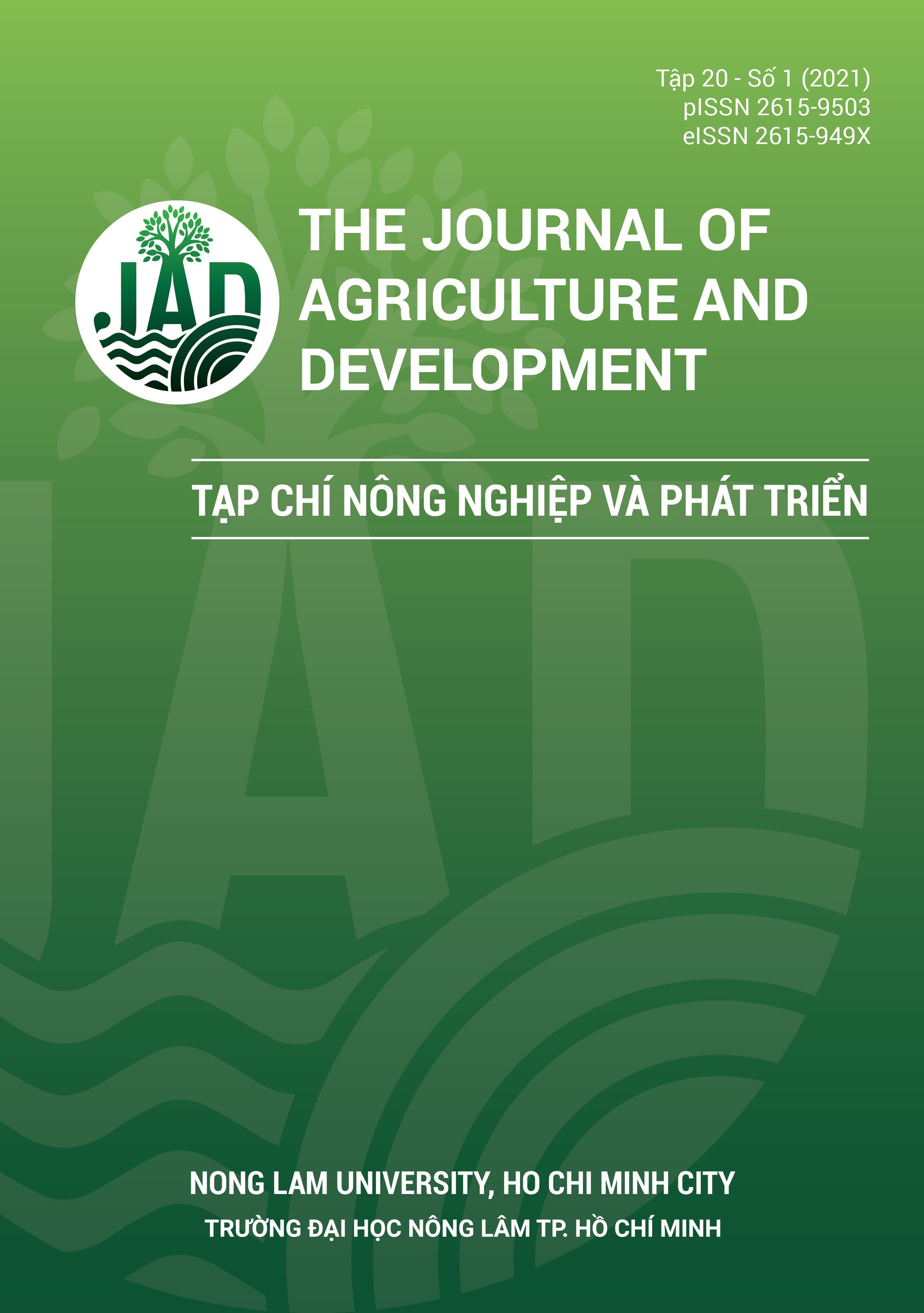Nghiên cứu động học phóng thích của tinh dầu chanh từ hạt vi bọc bằng phương pháp ion-gel
Main Article Content
Tóm tắt
Hạt Ca-Alginate vi bọc tinh dầu chanh bằng phương pháp ion-gel được thực hiện và sau đó ngâm trong dịch Chitosan để có hạt Ca-Alginate-Chitosan. Nồng độ CaCl2 tăng làm giảm sự phóng thích tinh dầu chanh. Nồng độ alginate (2 - 3%) và nhiệt độ nước ngâm ảnh hưởng đến sự phóng thích tinh dầu chanh (P < 0,05). Ở nhiệt độ càng cao, tốc độ phóng thích càng lớn. Độ phóng thích tinh dầu ở nhiệt độ 75oC cao hơn hai lần ở nhiệt độ 45oC. Ở nhiệt độ 45oC, sự khác biệt tốc độ phóng thích giữa 3 nồng độ alginate 2%; 2,5% và 3% rõ ràng và có ý nghĩa thống kê (P < 0,05). Tuy nhiên, ở nhiệt độ 60oC và 75oC, không có sự khác biệt về độ phóng thích giữa nồng độ alginate 2,5% và 3% (P > 0,05). Trong quá trình bảo quản hạt vi bọc trong môi trường CaCl2 1% ở nhiệt độ thường, sau thời gian 15 ngày đầu hệ Ca-Alginate-Chitosan phóng thích chậm hơn hệ Ca-Alginate khoảng 3\% nhưng không khác biệt giữa hai hệ sau 45 ngày. Điều này cho thấy nếu kéo dài thời gian lâu thì liên kết Ca-Alginate chiếm ưu thế so với liên kết Alginate-Chitosan.
Article Details
Tài liệu tham khảo
Anitha, K., Ramachandran, T., Rajendran, R., & Mahalakshmi, M. (2011). Microencapsulation of lemon grass oil for mosquito repellent finishes in polyester textiles. Elixir International Journal 40, 5196-5200.
Douglas, K. L., & Tabrizian, M. (2005). Effect of experimental parameters on the formation of alginate–chitosan nanoparticles and evaluation of their potential application as DNA carrier. Journal of Biomaterials Science, Polymer Edition 16(1), 43-56. https://doi.org/10.1163/1568562052843339
Fundueanu, G., Nastruzzi, C., Carpov, A., Desbrieres, J.,& Rinaudo, M. (1999). Physico-chemical characterization of Ca-alginate microparticles produced with different methods. Biomaterials 20(15), 1427-35. https://doi.org/10.1016/S0142-9612(99)00050-2
Kausadikar, S., Ashish, D. G., & Jyotsna, W. (2015). Microencapsulation of lemon oil by spray drying and its application in flavour tea. Advances in Applied Science Research 6(4), 69-78.
Martins, I. M., Maria, F. B., Manuel, C., & Alírio, E. (2014). Microencapsulation of essential oils with biodegradable polymeric carriers for cosmetic applications. Chemical Engineering Journal 245, 191-200. https://doi.org/10.1016/j.cej.2014.02.024
Park, S. J., Shin, Y. S., & Lee, J. R. (2001). Preparation and characterization of microcapsules containing lemon oil. Journal of Colloid and Interface Science 241(2), 502-508. https://doi.org/10.1006/jcis.2001.7727
Peng, H., Xiong, H., Li, J., Xie, M., Liu,Y., Bai, C., & Chen, L. (2010). Vanillin cross-linked chitosan microspheres for controlled release of resveratrol. Food Chemistry 121(1), 23-28. https://doi.org/10.1016/j.foodchem.2009.11.085
Silva, E. K., Giovani, L. Z., Angela, M., & Meireles, A. (2015). Ultrasound-assisted encapsulation of annatto seed oil: Retention and release of a bioactive compound with functional activities. Food Research International 78, 159-168. https://doi.org/10.1016/j.foodres.2015.10.022
Soliman, E. A., El-Moghazy, A. Y., El-Din, M. S. M.,& Massoud, M. A. (2013). Microencapsulation of essential oils within alginate: Formulation and in vitro evaluation of antifungal activity. Journal of Encapsulation and Adsorption Sciences 3(1), 48-55. https://doi.org/10.4236/jeas.2013.31006
Truong, V. (2020). Effectiveness of liquid jet breakup and jet cutting systems used in microencapsulation processes of cosmetics, pharmaceuticals and foods (Report of Project B2018-NLS13 funded by the Ministry of Education and Training of Vietnam). Nong Lam University, Ho Chi Minh City, Vietnam.
Truong, V., Nguyen, P. T., Ta, P. N. M., Nguyen, P. T., & Pham, N. T. C. (2020). Effects of type and concentra-tion of alginate on microencapsulation characteristics of lime essential oil (Citrus aurantifolia) produced by extrusion-dripping methods. The Journal of Agriculture and Development 19(1), 65-76.
Weinbreck, F., Minor, M., & de Kruif, C. G. (2004). Microencapsulation of oils using whey protein/gum arabic coacervates. Journal of Microencapsulation 21(6), 667-679. https://doi.org/10.1080/02652040400008499








